A stratified charge engine describes a certain type of internal combustion engine, usually spark ignition (SI) engine that can be used in trucks, automobiles, portable and stationary equipment. The term "stratified charge" refers to the working fluids and fuel vapors entering the cylinder. Usually the fuel is injected into the cylinder or enters as a fuel rich vapor where a spark or other means are used to initiate ignition where the fuel rich zone interacts with the air to promote complete combustion. A stratified charge can allow for slightly higher compression ratios without "knock," and leaner air/fuel ratio than in conventional internal combustion engines.

The Monosoupape, was a rotary engine design first introduced in 1913 by Gnome Engine Company. It used a clever arrangement of internal transfer ports and a single pushrod-operated exhaust valve to replace the many moving parts found on more conventional rotary engines, and made the Monosoupape engines some of the most reliable of the era. British aircraft designer Thomas Sopwith described the Monosoupape as "one of the greatest single advances in aviation".

Alfa Romeo Twin Spark (TS) technology was used for the first time in the Alfa Romeo Grand Prix car in 1914. In the early 1960s it was used in their race cars (GTA, TZ) to enable it to achieve a higher power output from its engines. And in the early and middle 1980s, Alfa Romeo incorporated this technology into their road cars to enhance their performance and to comply with stricter emission controls.

A two-stroke diesel engine is an internal combustion engine that uses compression ignition, with a two-stroke combustion cycle. It was invented by Hugo Güldner in 1899.
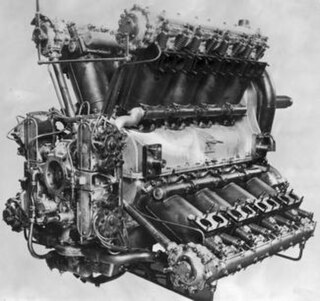
The Napier Cub was an unusual and very large experimental 1,000 horsepower (750 kW) 16-cylinder 'X' pattern liquid-cooled aero engine built by the British engine company D. Napier & Son. The Cub was the only Napier 'X' engine design. First flown on 15 December 1922 in an Avro Aldershot biplane bomber aircraft, the only other application was in the Blackburn Cubaroo. Only six engines of this type were ordered and produced.
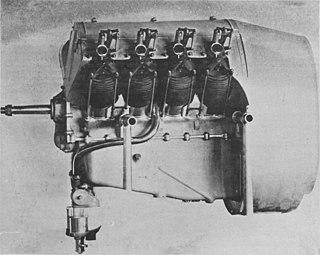
The Renault 70 hp or Type WB was a French V-8 aero engine that first ran circa 1907. It was also manufactured under license by Renault Limited of West Brompton, London between August 1914 and December 1918, three other companies, including Rolls-Royce, also produced the engine. A variant known as the Type WC used an external oil pump as opposed to the internal pump of the Type WB. The Renault V-8 engines were noted as inefficient but reliable, the inefficiency being mainly due to the excessively rich fuel/air mixture used to assist cooling.

The Fiat A.20 was an Italian aero-engine of the 1920s. It was a water-cooled V12 engine that was used by early versions of the Fiat CR.20 fighter and the Macchi M.41 seaplane.

The Green D.4 was a four-cylinder watercooled inline piston engine produced by the Green Engine Co in the UK in 1909. It produced about 60 hp (45 kW) and played an important role in the development of British aviation before World War I.
The Junkers L1 was the first engine manufactured by Junkers to fly. It was an air-cooled, upright 6-cylinder inline 4-stroke petrol engine only produced in small numbers and largely used for research, but led to the successful L5 and its V-12 development, the L55.
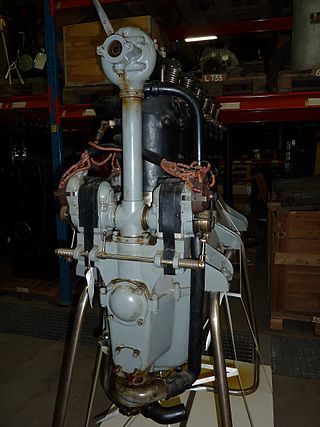
The Junkers L2 was Junkers' first water-cooled four-stroke engine and the first to be built on a production line, though only 58 were made. It was a six-cylinder inline engine and powered many Junkers aircraft until replaced by the more powerful L5.
Internal combustion engines come in a wide variety of types, but have certain family resemblances, and thus share many common types of components.
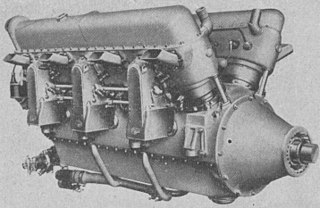
The Lorraine 12H Pétrel was a French V-12 supercharged, geared piston aeroengine initially rated at 370 kW (500 hp), but later developed to give 640 kW (860 hp). It powered a variety of mostly French aircraft in the mid-1930s, several on an experimental basis.
The Wilksch WAM series is a family of aero-engines for light and general aviation aircraft. WAM series engines are produced by Wilksch Airmotive in Gloucestershire, England. The engine outputs range between 100 hp (75 kW) and 190 hp (142 kW), and are suitable for both tractor and pusher configurations. Initially intended for homebuilt aircraft, the WAM engines may become certified for use on factory-built aircraft.
The Sunbeam Afridi was an aero-engine produced by Sunbeam during the First World War.
The Sunbeam Spartan was a British 12-cylinder aero-engine designed and built in 1916.
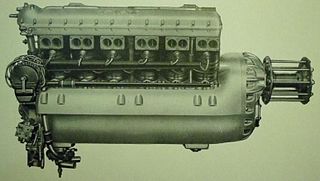
The Fiat A.24 was an Italian water-cooled aircraft engine from the 1920s.
The Fiat AN.1 was an Italian two-seat biplane from 1930, best known as a demonstrator of Fiat's first aircraft diesel engine, also named the Fiat AN.1.
The Clerget 16X was an experimental French 16-cylinder X engine built in about 1918.

An internal combustion engine is a heat engine in which the combustion of a fuel occurs with an oxidizer in a combustion chamber that is an integral part of the working fluid flow circuit. In an internal combustion engine, the expansion of the high-temperature and high-pressure gases produced by combustion applies direct force to some component of the engine. The force is typically applied to pistons, turbine blades, a rotor, or a nozzle. This force moves the component over a distance, transforming chemical energy into kinetic energy which is used to propel, move or power whatever the engine is attached to. This replaced the external combustion engine for applications where the weight or size of an engine were more important.
The Diesel Air Dair 100 is an opposed-piston diesel aircraft engine, designed and produced by Diesel Air Ltd of Olney, Buckinghamshire for use in airships, home-built kitplanes and light aircraft. The prototype was built in the 1990s and exhibited it at PFA airshows. Although Diesel Air engines have been fitted to an AT-10 airship and to a Luscombe 8A monoplane, production numbers have been very limited.











